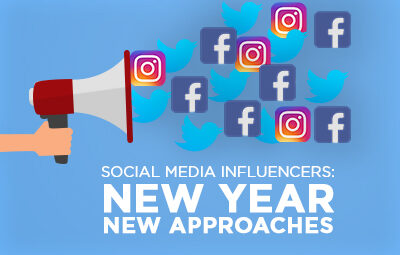This past year, “influencer marketing” gained a lot of traction in the social media world. It quickly became the buzzword everyone was talking about, and the new approach to marketing. So what is influencer marketing? Simply stated, it’s a way to attach your brand to well-known social users who have a dominant presence on social media, leveraging their popularity to increase the popularity of your product or service. A form of marketing that focuses on influential users rather than an entire market, it helps reach niche markets and improve brand loyalty. After all, data from influencer marketing platform MuseFind shows that 92 percent of consumers trust an influencer more than they trust an ad or a traditional celebrity endorsement (Sassine, 2017). Is investing in “social media influencers” really worth it? Has the fad run its course? What approaches should be taken in 2018?
Using social media influencers as a marketing strategy creates the opportunity to form more genuine relationships with influencers who can then build relationships with consumers for you. An influencer can reach and attract an audience in a way that your brand may not be able to. When content is posted by influencers, it taps into consumers’ preferences and feels more personal, ultimately making them trust the recommendation more. Using this method, influencer content has been and will continue to be desirable and pervasive (Wiley, 2017). Consumers want authenticity—and while leveraging a social user’s personal influence is, in reality, a marketing strategy, to an end user it feels like a recommendation from a friend. Influencers are perceived as having an entire experience to share, not just a product to plug.
Take the app Influenster, for example. Influenster is a product discovery-and-review platform for consumers. The app employs analytics to measure its users’ influence on social media, and then sends free product samples so consumers can use the app as a discussion board to share recommendations. Consumers are more likely to try, talk about, and purchase products when it feels like they are genuinely sharing the experience, and when their choices are both guided and affirmed by the opinions of influencers.
Brands have gradually been shifting their marketing dollars to influencer strategies. But the development of best practices is a recent change. Companies and influencers themselves are adapting their processes and truly evolving, but how well are the processes working? ( Wiley, 2017). Social media professionals frequently hear about the many benefits generated through working with influencers, including high affinity and credibility as well as incremental reach, but how cost-effective is it? There is also the issue of external vs. internal influencers, and whether companies are leveraging their own industry experts and thought leaders? Although it’s likely that, as influencer marketing continues, brands will reevaluate their resources and stop relying on internal staff (Wiley, 2017), such a move could be detrimental if those “in-house” resources are valuable, effective, and inexpensive. At UMSocial, for example, we leverage the intellectual capital and the communications expertise of our leaders and social media gurus every day, to the benefit of our social media communities.
Influencer marketing played a large role in digital marketing in 2017, but as brands focus on driving onsite engagement and capturing brand content more visually, what digital marketing trends will we see in 2018?
Mobile
Mobile represents the vast majority of media minutes for consumers and we can expect to see more brands leveraging mobile-specific content. Simplicity and speed are at the heart of mobile-friendly content and we will start to see a shift in that direction.
Ephemeral content
It comes as no surprise that live content that expresses the point quickly will continue to be popular, with the growth of platforms like Snapchat and Instagram. Users are drawn to the visuals and “exclusivity” of the content, and it taps into the FOMO part of our brains (Miels, 2017).
User-Generated Content
Influencer marketing is based on the fact that consumers trust other consumers, not brands. User-generated content taps into the personal side of influencer marketing even more, forming and solidifying that relationship. It is being used more and more to make consumers a part of the stories (Meils, 2017).
As digital marketers enter a new year, we revisit our current strategies and tactics and ask ourselves what is going well, what needs a makeover, and how we can improve. UMSocial has already begun implementing some of these strategies for improving the ways we communicate and we look forward to expanding them in 2018, while continuing to creatively leverage our content and capitalize on our resources.
Be social. Stay social. #UMSocial
Post written by McKenna Whipple, Social Media Content Strategist at The University of Michigan.
Matthews, Kristen. (2014). Your Influencer Marketing Resource. GroupHigh.
Miels, Emily. (2017). 5 Digital Marketing Trends to Watch for in 2018. E-Power Marketing.
N.A. (2017). Social Media Influencers. GroupHigh.
N.A. (2017). What Is An Influencer? Influencer Marketing Hub.
N.A. (2017). What is a social media influencer? PIXLEE.
Wiley, Danielle. (2017). Seven Influencer Marketing Trends To Watch For In 2018. Forbes.
Zuercher, Brian. (2017). Six stats on the importance of trust in influencer marketing. Search Engine Watch.



